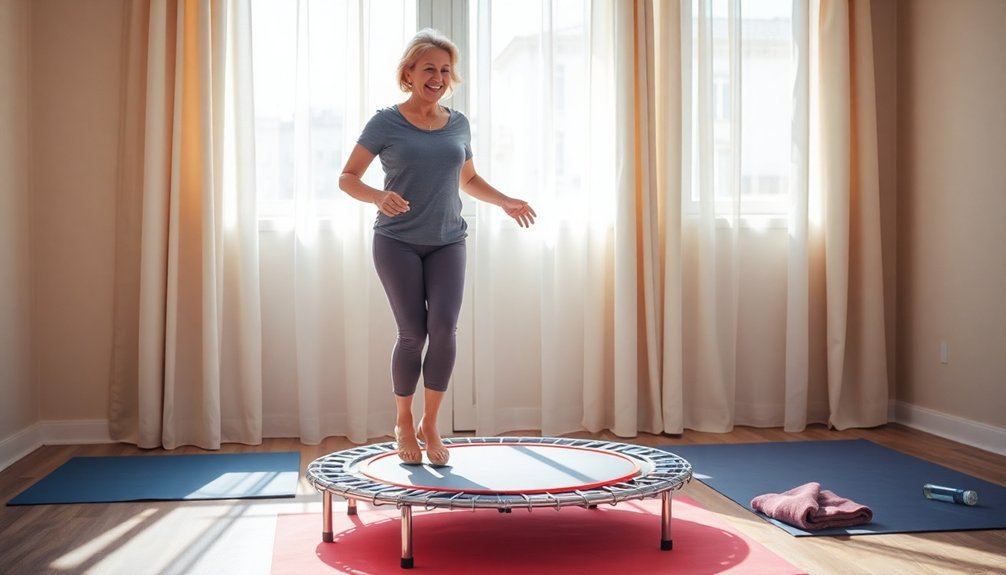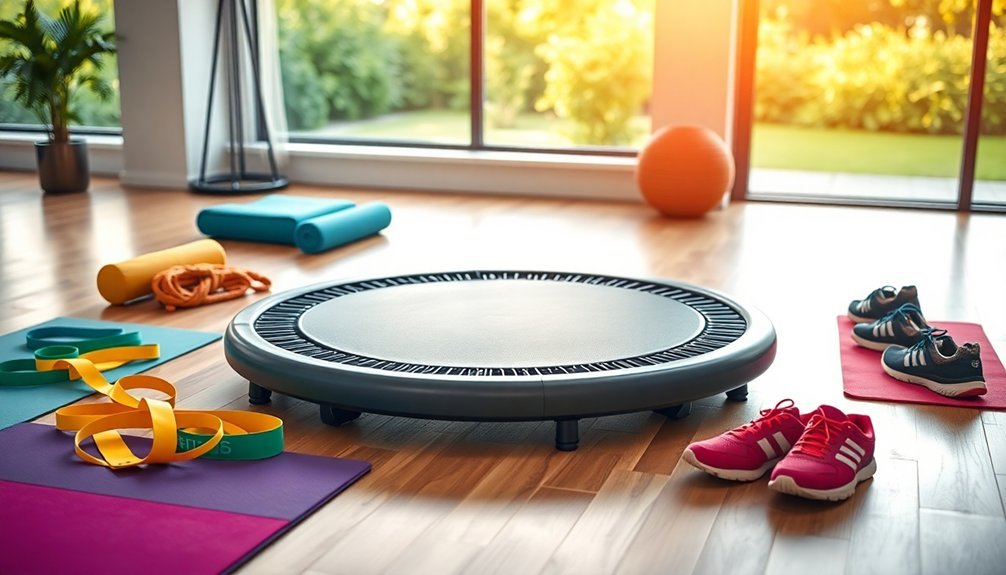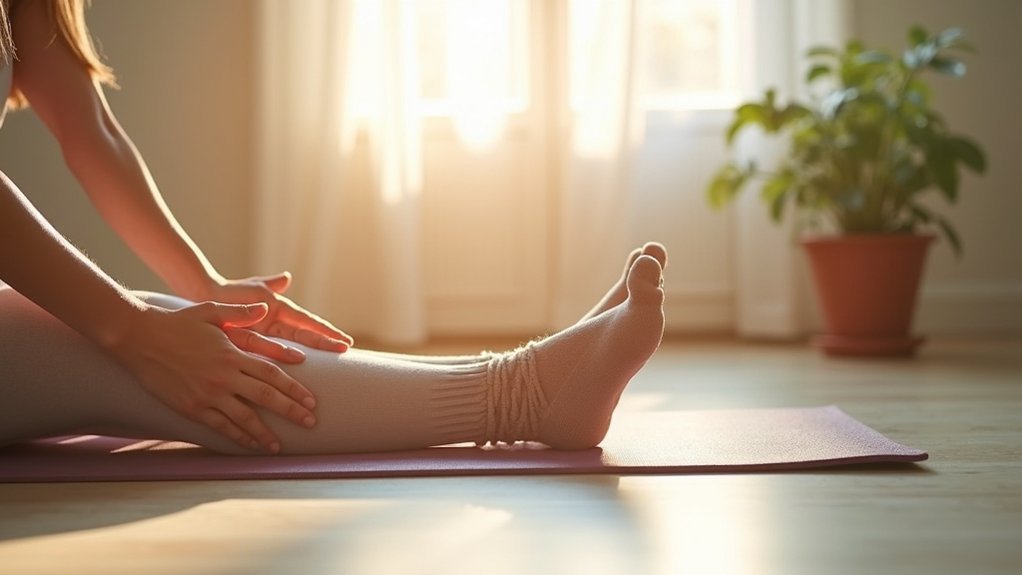Rebounding on a mini-trampoline offers an ideal low-impact cardio solution for bad knees, absorbing up to 87% of impact while still delivering excellent cardiovascular benefits. You'll strengthen supporting muscles, improve joint mobility, and reduce stiffness without the pain of high-impact exercises. Start with gentle, controlled bounces using proper form—slightly bent knees and shoulder-width stance. This joint-friendly workout can transform your fitness journey while protecting your knees from further damage.
Why Rebounding Is Ideal for Those With Knee Issues

Four key factors make rebounding an excellent exercise choice for people with knee problems.
Unlike high-impact workouts that stress your joints, rebounding provides a gentle, low-impact alternative that actually supports knee health rather than deteriorating it.
While high-impact exercises damage joints, rebounding protects your knees while still delivering all the fitness benefits you need.
The mini-trampoline's elastic surface absorbs up to 87% of impact, protecting your knees while still delivering cardiovascular benefits.
You'll experience improved joint mobility and reduced stiffness as you bounce, while simultaneously strengthening the muscles that support your knee joints.
Perhaps most importantly, rebounding enhances circulation around your knees, which helps reduce pain and swelling.
The gentle bouncing motion also stimulates your lymphatic system, facilitating the removal of inflammatory compounds that can contribute to knee discomfort.
The Boogie Bounce rebounder's patented T-bar offers additional stability and support, making it ideal for those with knee issues who may have balance concerns.
The Science Behind Low-Impact Bouncing Benefits
The remarkable science behind rebounding explains why it works so well for problematic knees. When you bounce, the trampoline surface absorbs up to 87% of the impact that would normally stress your joints on hard surfaces.
Each bounce creates a unique gravitational stimulus that strengthens muscles and bones without targeting specific joints.
Your body experiences three distinct phases during rebounding:
- Weightlessness at the top of each bounce, giving joints momentary relief
- Gentle acceleration downward, engaging muscles gradually
- Deceleration on the mat that distributes force evenly across your body
This cyclical pattern stimulates your lymphatic system, improves balance, and strengthens stabilizer muscles around your knees—all while burning calories more efficiently than running, in just a third of the time. NASA research demonstrates that just 10 minutes of rebounding provides equivalent cardiovascular benefits to 30 minutes of running.
Getting Started: Equipment Selection for Knee Safety

Selecting the right rebounding equipment makes a critical difference when you're dealing with knee problems. Choose rebounders with high shock absorption capabilities and adequate mat thickness to minimize impact. Spring-free designs typically offer better protection for sensitive joints. Higher quality rebounders are essential since cheaper models may lead to injuries.
| Equipment Type | Knee Safety Rating | Best For |
|---|---|---|
| Spring-Free Rebounders | Excellent | Severe knee issues |
| Rebounders with Handles | Very Good | Beginners, stability |
| Mini-Trampolines | Good | Limited space, moderate issues |
Don't prioritize price over quality—invest in equipment that can properly support your weight. Look for models with stability features and non-slip surfaces to prevent accidents. Regular maintenance is essential, so check for wear on springs, mats, and frames before each use. A rebounder with adjustable tension allows you to customize impact levels as your knees strengthen.
Proper Rebounding Techniques to Protect Your Joints
Mastering proper technique when rebounding can make all the difference between a therapeutic exercise and one that worsens knee pain. When you step onto your rebounder, remember to center your weight evenly on both feet and engage your core muscles to protect your joints.
Focus on these essential movements to safeguard your knees:
- Land softly with slightly bent knees, allowing your body to absorb impact gradually rather than jarring your joints.
- Keep your bounces low and controlled, maintaining balance by using the handlebar if needed.
- Position your feet shoulder-width apart and avoid leaning forward, which can place excessive pressure on your knees.
The low-impact nature of rebounding makes it particularly beneficial for people with joint issues who still want to enjoy cardiovascular exercise.
Always warm up before increasing intensity and listen to your body's signals to prevent overexertion.
Progressive Workout Plans for Different Knee Conditions

Developing a progressive workout plan tailored to your specific knee condition can dramatically improve your rebounding experience and rehabilitation outcomes.
Begin with just 2-3 sessions weekly, performing 3 sets of 10-15 repetitions of gentle bouncing motions.
For patellofemoral pain, keep exercise intensity low with pain levels below 3/10. Start with hip-focused movements before advancing to knee-dominant exercises. Consider reviewing model performance metrics from research repositories to identify the most effective rehabilitation exercises.
In severe knee conditions, commit to an 8-12 week program utilizing the rebounder at 60-85% of your maximum effort.
As you progress, gradually increase resistance and session length.
If you're returning after knee pain, eliminate high-impact movements initially and focus on mobility.
Monitor how your knees respond post-workout, ensuring pain returns to baseline before advancing to more challenging rebounding variations.
Combining Rebounding With Other Knee-Friendly Exercises
You'll get the most out of your rebounding routine by combining it with complementary exercises like strength training for muscles supporting your knees.
Gentle stretching routines before and after rebounding can improve flexibility while reducing stiffness in your knee joints.
Water therapy exercises, when paired with regular rebounding sessions, create a well-rounded approach that maximizes rehabilitation benefits while minimizing joint stress. The use of a rebounder with safety features such as sturdy frames and covers over springs ensures protection during your exercise routine, especially important for those with knee concerns.
Strength Training Synergy
While rebounding offers tremendous benefits on its own, combining it with complementary strength training exercises creates a powerful synergy that maximizes results for those with bad knees.
By pairing your rebounding sessions with targeted resistance training, you'll strengthen the muscles that support your knee joints, improving stability and function. This approach is particularly effective since rebounding is low-impact exercise that places minimal stress on recovering knee joints.
Consider incorporating these knee-friendly strength exercises into your routine:
- Modified squats – Keep movements shallow and controlled, focusing on proper alignment with knees tracking over toes.
- Resistance band work – Use bands for lateral movements that strengthen hip abductors and stabilizers without knee strain.
- Seated leg extensions – Strengthen quadriceps with partial-range movements that don't aggravate knee pain.
Always maintain proper form and progress gradually to prevent injury while building the supportive musculature your knees need.
Gentle Stretching Routines
Integrating gentle stretching routines with your rebounding practice creates an ideal environment for knee rehabilitation and long-term joint health.
Begin with calf raises to build ankle strength and support knee stability, then progress to wall squats that strengthen knee muscles without excessive strain.
For best results, incorporate hamstring stretches to reduce tension around your knees, and add side-lying leg lifts to strengthen your quadriceps. Maintaining a slight bend in knees throughout your rebounding exercises prevents joint locking and provides natural shock absorption.
Remember to maintain proper alignment with knees over toes during all exercises while keeping your core engaged for added stability.
After rebounding sessions, try gentle yoga poses like warrior or pigeon to stretch knee muscles and aid recovery.
These complementary stretches enhance flexibility and balance, creating a thorough approach that maximizes rebounding's benefits while protecting your vulnerable knees.
Water Therapy Integration
Water therapy offers a perfect complement to rebounding exercises for those nursing bad knees. The buoyancy of water reduces joint stress while providing natural resistance that strengthens knee-supporting muscles.
By alternating between these two low-impact cardio methods, you'll maximize mobility while minimizing discomfort.
Try this combined approach for ideal results:
- Start with water walking or cycling to warm up inflamed knees, utilizing hydrostatic pressure to reduce swelling.
- Shift to gentle rebounding sessions, focusing on stabilization and controlled movements.
- Finish with targeted water exercises like straight leg marches or kickboard knee raises to enhance flexibility.
This integration delivers thorough benefits—improving balance, strengthening supporting muscles, and maintaining cardiovascular fitness—all while protecting your vulnerable knee joints. Warm water environments (92-98 degrees) provide additional therapeutic benefits as warm water soothes joints and improves flexibility during your exercise routine.
Success Stories: Real People With Knee Problems Who Transformed Through Rebounding
Real-life success stories often provide the most compelling evidence for rebounding's effectiveness for knee problems.
Heather's experience shows how she successfully shifted to rebounding to protect her pre-existing knee injury while still enjoying fitness improvements.
Kelly's journey is particularly inspiring—after multiple knee surgeries, she found that rebounding allowed her to manage both her knee issues and asthma without discomfort.
She achieved impressive fitness gains that might've been impossible with high-impact exercises.
What's common across these testimonials is the reported reduction in pain and increased knee mobility.
Many users find that rebounding's low-impact nature—reducing joint stress by up to 1/6 compared to walking—allows them to maintain cardiovascular fitness without risking further damage to vulnerable knees.
Like Maddy's treatment for IT band syndrome, rebounding offers an alternative workout routine that emphasizes symptom management while still allowing consistent fitness activity.
Frequently Asked Questions
Can Rebounding Help With Post-Knee Surgery Rehabilitation?
Yes, you can use rebounding for post-knee surgery rehabilitation. It's low-impact, strengthens supporting muscles, improves balance, and enhances circulation—all beneficial for recovery when guided by your physical therapist's recommendations.
How Does Rebounding Compare to Water Aerobics for Knee Problems?
Water aerobics offers zero impact on joints while rebounding provides low-impact exercise. You'll find both strengthen knees, but water's buoyancy may be gentler if you're experiencing severe knee pain or post-surgery recovery.
Is Rebounding Safe for Those With Knee Replacements?
While rebounding can be suitable after knee replacement, you'll need your doctor's clearance first. Start with gentle bounces, use stabilizing bars if needed, and stop if you experience pain or discomfort.
How Often Should I Rebound for Optimal Knee Health Benefits?
Start with 5-10 minute sessions 2-3 times weekly, gradually increasing to 20-30 minutes 3-5 times weekly as your knees adapt. You'll want to maintain gentle bounces and always listen to your body's signals.
Can Children With Knee Conditions Safely Use Rebounders?
Yes, children with knee conditions can safely use rebounders with proper supervision. You'll want to guarantee they use quality equipment, maintain proper technique, and get healthcare professional approval for their specific condition first.
In Summary
You've discovered a knee-friendly way to enjoy cardio without the pain. Start slowly, maintain proper form, and listen to your body. As you build strength and confidence on your rebounder, you'll notice improved mobility and decreased discomfort. Don't let knee problems keep you sidelined—rebounding offers the perfect balance of effective exercise and joint protection. Your knees will thank you!





Leave a Reply